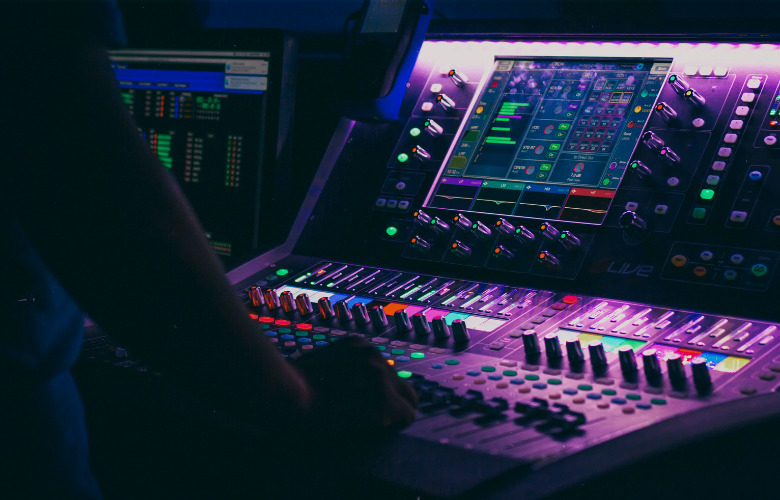
Stagehands often joke that we aren’t paid to run a show track. We’re really there to fix problems and (on tour) load the show in and out. With a little bit of direction, anyone can follow a track: page a curtain, swap a microphone or move something from one place to another. You hire a prop master because she has specialized knowledge and can rebuild or repair a prop that breaks or get an audio technician because she actually knows the components of the system and can suss out a problem.
Troubleshooting, especially mid-show, is mentally demanding. You have to run through all possible scenarios, eliminate them down to the most likely culprit, and execute the fix or workaround all within the space of moments. Backstage, this comes in the form of video, mics, or com malfunctioning, usually armed with all the information of, “This sounds weird, can you fix it?” as someone points to their beltpack.
When you’re out at FOH, your problems usually center around a glitch with the console, something making a noise that it’s not supposed to in the house, or trying to work around mic issue as the A2 works to fix things. As always, this is while mixing the show, because you’re a position that has a specialized track, so you actually are paid to run the show.
While fixing problems on the fly, even in non-catastrophic situations like switching from a sweat out main mic to a clean back up, your reaction time matters. It’s the difference between missing a word or an entire line as you think through the process of which channel you have to go to or which page of user assigned macros you need to be on.
Have you ever noticed it feels like it takes longer to walk to a new place than it does to walk back from it? You’re following the same route at the same pace, but something feels like it could be two completely different trips. What’s actually happening is that, on the way there, your brain is processing new information, which takes just the tiniest bit longer than when you’re walking back and now all your brain has to do is register a familiar sight.
The same thing can happen when you troubleshoot. If you’ve already worked through and fixed a kind of problem, you already know how to react and your brain can simply reference information instead of creating an entirely new plan from scratch. And it gets better: you don’t even have to physically experience a situation for your brain to pick up cues faster.
I first heard the term in the podcast episode “Don’t Accentuate the Positive” of The Happiness Lab series. (I highly recommended the series, especially if you have any interest in psychology, plus that particular episode has a fascinating story about Michael Phelps.) While listening, I found I’d developed a habit of negative visualization over the past several years without realizing that that was what I was doing.
A few months into a run, I usually reach a point where I’m comfortable with the show and the company has settled into a routine, so everyone can relax just a bit. At this point, I’d start to play a “what if” game. If I noticed a cue would be easy to fire at the wrong time if I wasn’t paying attention, I’d walk through the process of what would happen if I did make that mistake. I’d make it my own mental exercise, going through what chain reaction that cue might set off and what specific process I’d have to use to recover from the mistake.
That’s what negative visualization is: mentally walking through a problem scenario. The benefit is that in a figurative world, you can also work through multiple solutions to that problem until you find the best one. So, in the event you find yourself in that situation, your mind reacts faster to decide on a course of action because it’s already done it, even if the trial run was just in your head.
I had an actress who occasionally sweated out her main mic, but always at the same point in the show. It became common enough that I made a point key up the macro page to the one with her backup shortcut if I knew the backstage area was warmer than usual, or it was just a hot day. In some instances, she would sweat out even in colder climates, and even for those, I was so used to the combination of buttons to switch to her back up, it was like I had my own cheat code which took the work of moments with minimal thought.
In another experience, I had the main fader bank on the console reset mid-show. I had a freeze of an “uh oh” moment, then switched to the backup engine. That same glitch has happened a couple times over the course of a few years, but even with hundreds of shows between occurrences, the second time it happened, I didn’t even have that initial pause, my brain was able to recognize the similar situation and my hand immediately moved to switch engines. Now, if something happens on the console, I automatically default to the instinct to reach for the Engine A/B button. As my body is reacting, my mind can process if I should actually change or not so, if I need to, my hand’s already there, if not, I can pull back.
The news that Broadway and most large events won’t come back this year is demoralizing, and all of us face the hard reality of deciding on a course of action to either get us through the short term or consider changes on a grander scale. But the challenges won’t stop there. As the entertainment industry focuses on its eventual reopening, we’re looking to do it as we create a more inclusive, knowledgeable, and healthier environment, especially for the BIPOC and marginalized artists in our communities. For many white people, that requires us to be activists as well as advocates for our fellow technicians, musicians, and actors when we get back to work. For those of us not used to speaking up or purposely exposing ourselves to confrontational situations, we know it’s a necessary if intimidating task. Especially so in workplaces where off-hand racist or sexist comments were previously considered “just kidding around” and bringing attention to them might have been met with “just ignore it,” “it’s too much of a hassle, and it’ll piss everyone off,” or “well, what did you expect?”
As we face all these problems and more, negative visualization can be a helpful tool to reevaluate and rearrange our future plans or make an effort, not only to step out of our comfort zones but to actively do the hard work of de-programming years and even decades of ingrained behaviors. If there’s a silver lining in all this, we’ll get plenty of opportunities this year to retrain our brains and mentally practice constructive reactions as we head towards getting back to work.
Article by SoundGirl: Heather Augustine
Another great article by SoundGirls: The Financial Case for Increasing Diversity in Live Audio
Follow SoundGirls on Instagram, Twitter


The mission of SoundGirls.org is to inspire and empower the next generation of women in audio. Our mission is to create a supportive community for women in audio and music production, providing the tools, knowledge, and support to further their careers. SoundGirls.Org was formed in 2013 by veteran live sound engineers Karrie Keyes and Michelle Sabolchick Pettinato and operates under the Fiscal Sponsorship of The California Women’s Music Festival, a 501(c)3 non-profit organization. In 2012, Karrie and Michelle participated in the “Women of Professional Concert Sound” panel at the AES Conference in San Francisco. The panel was hosted by the Women’s Audio Mission (WAM) and moderated by WAM founder Terri Winston. Terri brought together five women working in live and broadcast audio. The groundbreaking panel (which also included Jeri Palumbo, Claudia Engelhart and Deanne Franklin), provided young women and men a glimpse into life on the road, tips and advice, and a Q & A with the panelists. More importantly though, was how incredibly powerful the experience was for the panelists. We had all been in the business for 20 years or more, yet most of us had never met before that day and within minutes we bonded like long-lost sisters. We were struck by how similar our experiences, work ethics, and passions were and wondered why our paths had never crossed and how our careers would have been different had we been there to support each other through the years. Each of us are strong on our own, but together we were even stronger and a powerful force. We were empowered. Each of us had been asked hundreds of times in our careers: Are there other women doing sound? How did you get into sound? How would a young woman go about getting into sound? Through creating SoundGirls.Org, we hope to establish a place for women working in professional audio to come for support and advice, to share our success and failures, our joys and frustrations, and for empowerment and inspiration.
Read Full Profile© 2021 TheatreArtLife. All rights reserved.

Thank you so much for reading, but you have now reached your free article limit for this month.
Our contributors are currently writing more articles for you to enjoy.
To keep reading, all you have to do is become a subscriber and then you can read unlimited articles anytime.
Your investment will help us continue to ignite connections across the globe in live entertainment and build this community for industry professionals.